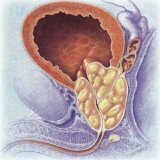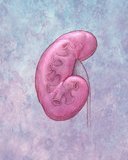Case history: prostate adenoma

Case history.
After reaching 45 years, the number of men with this diagnosis is significantly increased by 15 - 20%, and in the elderly - by about 50 - 90%.It is necessary to know that if such a diagnosis is made, this does not mean that every patient will go through an operation. Over the past 10 - 15 years, doctors have changed their attitude to the diagnosis of benign prostatic hyperplasia. Earlier, surgical intervention was considered to be the most effective( it was used in 80% of cases), while the remaining 20% were considered conservative, but now everything is vice versa. Such tangible changes were influenced by modern approaches in diagnostic methods and a great awareness of people. For example, in any district clinic you can get an ultrasound examination. About 20 years ago, doctors dealt with very neglected stages of the disease, which were to be treated only by surgical intervention, and nowadays in the case of early detection of the disease, it is possible to apply more "calm" therapy.
Symptoms of the disease: prostate adenoma.
The very first symptom that can alert is frequent urination, especially at night. If earlier a man in the whole night had never gone to the toilet, and now visits him 3 times, perhaps more often, you can safely say that the prostate gland is not in order. The reason for this is that the adenoma grows and starts to squeeze the urethra, this prevents the bladder from completely being emptied, so desires often arise. Another symptom - the urine stream is weakened( or its discontinuity occurs), the time of urination increases. In addition, there is no sense of relief from the fact that the bladder is emptied. Similar symptoms can be expressed to a greater or lesser degree, it depends on the degree of disturbance, but they get a lot of inconveniences: it is impossible to get a good night's sleep, the quality of life worsens, and you need to see a doctor. After the doctor has examined, examines the history and results of the diagnosis of ultrasound, appropriate treatment methods are selected. They are very different, depending on what stage the disease is at.
Causes of risk of adenoma formation.
The main factor and the cause of the risk of adenoma formation is predisposition of genetics: in the case when men - close relatives were ill with this disease, there is a very high probability of developing prostatic hyperplasia. Another dangerous factor - various inflammations and diseases of the reproductive system. Prostatitis is a very dangerous problem, they even occupy the third place after adenoma and prostate cancer. An important role in the appearance of prostatic hyperplasia is played by bad habits, obesity, hypodynamia, sexual dissatisfaction, and much more.
Of course, you can accept that you can not affect genetics, do not pay attention to all the circumstances and wait until the adenoma declares itself. And you can significantly reduce the risk to a minimum: a healthy lifestyle, normal weight, a good sex life. In this case, all the above-mentioned phenomena will not arise, and therefore the adenoma can not develop. By the way, the opinion that adenoma affects the reduction of sexual male activity is erroneous, as well as other diseases of the second life half( hypertension, diabetes), their appearance is caused by a decrease in the level of testosterone and perestroika associated with age. In some countries, such a diagnosis is very rare or it does not happen.
In the first place is Japan and countries whose residents in the food ration make the most part seafood. And in Europe and the US, where the population eats, mainly fast food, there is an overweight and a sedentary lifestyle, the disease is very common.
What to do if a presumed diagnosis of an adenoma is made.
The next step after the presumed diagnosis of "adenoma" is put is to completely eliminate cancer, since both ailments have common symptoms. This can be established by a blood test for the presence or absence of a specific antigen. For example, in Europe, all men after 45 years once a year are required to do this analysis, as this will reveal prostate cancer at an early stage. After the doctor has ascertained that there is no malignant process, to evaluate the optimal treatment regimen, an evaluation of the functional features of the genitourinary system takes place: whether the renal function is not impaired.
The first degree of adenoma is not accompanied by serious functional disorders, only the quality of life suffers, and preparations of plant origin are used. They are quite effective, but they do not give a guarantee of a complete cure for the disease, they can get rid of the inconveniences that it brings. Patients live normally for dozens of years. The second and third degree of adenoma require more decisive steps: you need to remove the obstruction, which affects the urination process. At the second stage there is a big risk of occurrence of a secondary infection, the cystitis can develop. In this case, prescribe alpha-adrenoblockers and other drugs of domestic and foreign production that remove the main symptoms and improve the quality of life, although this in general does not affect the growth of the gland.



